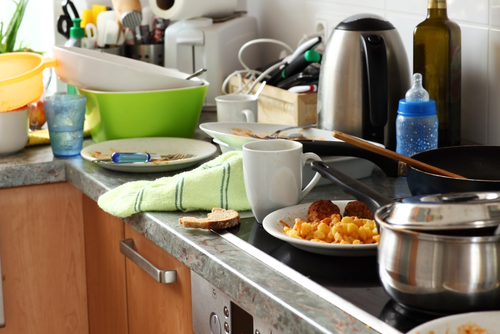Would the government let people eat in your home if you were a restaurant?
By Angela Silva
You feel a sense of pride after finishing a home-cooked meal that leaves your family finger-licking and asking for more. You enjoy teaching your kids how to bake and cook, and sometimes letting them experiment on their own. Your kitchen is a place of creativity and a source of happiness. But you could be inadvertently creating some health hazards that would cause an outcry if they were discovered in a restaurant or public kitchen. If a health inspector came knocking on your door, would you pass the inspection? According to a recent study by the Los Angeles County Department of Public Health, one in seven homes would fail a restaurant style health inspection, and only three out of five would receive an A or B grade. Here are five common mistakes that are made in the kitchen at home that are considered health violations in restaurants.
1. Double duty dish rags – Using the same dish rag to dry your hands and to wipe down counters causes cross-contamination. After you cut raw poultry, meat, or dairy and then wipe your hands on a towel after washing them, you are spreading the germs to the towel. By using that same towel to wipe the counters or dishes, you are spreading those germs to other surfaces.
a. The proper way: Have a separate towel for drying hands and for wiping counters or other surfaces. Soak the counter towels in a solution of bleach and water.
2. Foregoing the cooking thermometer – Undercooked foods are one of the leading causes of foodborne illnesses. Restaurants are required to know the exact temperature of their ovens and grills, and although we may think we’re preheating our kitchen ovens to 350 degrees, a test by Cook’s Illustrated found that different ovens set to the same temperature can vary by as much as 90 degrees.
a. The proper way: Especially when cooking meat, always use a cooking thermometer to ensure it reaches the proper temperature. For poultry, the internal temperature must be at least 165 degrees, and for ground beef products it should be at least 160 degrees.
3. Neglecting the kitchen floor – That’s right, the floor! If a health inspector found any cracks or missing sections of grout or tile, you would face a major health violation. Bacteria and viruses will grow and thrive in cracks in the floor, and as you walk over them you will spread those germs throughout the house.
a. The proper way: Always wet mop your floors, don’t just sweep. Use bleach to clean them if the type of floor allows it. If you discover a crack, fix it immediately.
4. Keeping the fridge too warm – Many people don’t realize that a major source of bacterial growth is due to the temperature of their refrigerator. Keeping the temperature beneath 40 degrees with discourage bacterial growth. Sometimes the refrigerator thermometer can be inaccurate, so using a separate one will ensure its set to the proper temperature.
a. The proper way: keep a thermometer near the front of the refrigerator. When the door is open, the front is the first to warm up. This way you’ll know for sure that the entire refrigerator is a safe temperature.
5. Washing in a full sink – The germs from your hands will wash away and right onto any dishes or pans in the sink. In a restaurant setting, workers must wash their hands in a separate sink than where food is rinsed or dishes are washed. Germs from hands can get onto the surface where produce is washed and cut.
a. The proper way: Keep the sink clear of any dishes before you wash your hands, and use separate towels for drying hands and drying dishes. Keep liquid soap and paper towels or dry towels in the bathroom for hand-washing.




No Comment